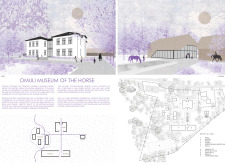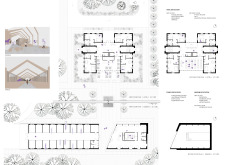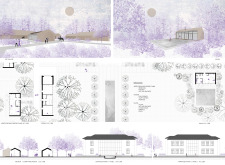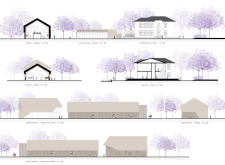5 key facts about this project
The architecture of the Omuli Museum showcases a harmonious blend of natural materials and modern design principles. Key features include extensive use of glass to promote transparency and connection with the surrounding environment, wooden structures that provide warmth and comfort, and concrete elements offering structural integrity. The careful selection of materials aligns with sustainable practices, ensuring minimal environmental impact while enhancing the overall aesthetic appeal.
Community Engagement and Educational Purpose
A defining characteristic of the Omuli Museum is its focus on community engagement and education. The spatial organization fosters interaction among visitors, artists, and horses, creating a vibrant atmosphere. The museum itself features flexible exhibition spaces that can be adapted for workshops and demonstrations, promoting hands-on learning opportunities. The inclusion of artist studios encourages creative expression and collaboration, enhancing the educational experience.
The integration of outdoor and indoor spaces allows for various activities related to horse riding, training, and exhibitions. Outdoor facilities, including a riding arena and landscaped gardens, offer additional areas for visitors to engage with equine culture in a natural setting. This thoughtful design promotes not only individual learning but a sense of community among users.
Unique Design Approaches
The Omuli Museum distinguishes itself from similar projects through its unique architectural approach, emphasizing a blend of art, functionality, and sustainability. The concept of creating a "village" layout integrates multiple structures while maintaining a cohesive identity. Each building functions independently yet is interconnected, promoting collaboration and social interaction.
Additionally, the museum prioritizes ecological responsibility, leveraging local materials and sustainable building practices. The design respects the surrounding landscape, ensuring harmonization with nature. This careful consideration of site context enables the project to serve as both an educational facility and a tranquil retreat for visitors.
For further insight into the project’s architectural plans, sections, and designs, readers are encouraged to explore the detailed presentation of the Omuli Museum of the Horse. An examination of the architectural ideas behind this project provides a deeper understanding of its innovative approach and dedication to equine culture.


























